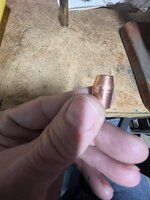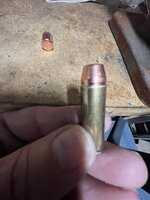- Messages
- 198
- Reactions
- 98
I have a new to me Marlin 336 44mag rifle. I am loading Remington brass with 11.4 grains of unique with a berrys 240 grain flat point bullet. The bullet has a cannelure. My AOL is 1.610. This seats it right under the cannelure. I am applying a light crimp with a Lyman's crimping die. Should I shorten the AOL so the crimp is in the cannelure or is crimping under the canalure ok?
Thanks, Edmon


Thanks, Edmon














